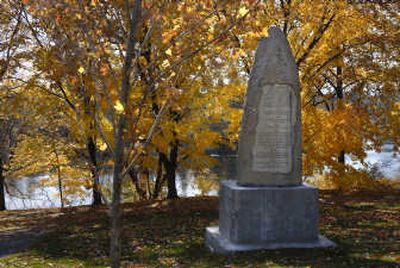Landmarks: Plantes Ferry a historical hot spot

There were so many historically significant events that took place at the site of the old Plantes Ferry in Spokane Valley that there was barely room to acknowledge every one of them on the monument located along Upriver Drive about 300 feet west of the entrance to Plantes Ferry Regional Park.
That’s probably why the monument is some 20 feet tall – a 14-foot piece of granite atop a cement base, all weighing 23,800 pounds – with the north-facing side covered with dates and text documenting it all.
This time of year, the monolith is framed by trees with leaves turning an assortment of autumn colors, and the Spokane River flowing softly by. A small trail passes between the monument and the river, a spur of the nearby Centennial Trail.
What the monument commemorates is the erection in 1849 of the first residence in Spokane Valley (a cabin built by Antoine Plante), the construction of Plantes ferry across the river in 1851, the visit to the site by Gov. Isaac Stevens in 1853 (his first stopping place as governor in Washington Territory), the signing of a peace treaty with Indians and the organization of the first two territorial militia companies (the Spokane Invincibles and Stevens Guards) in 1855, the Mullan Road military trail reaching that location in 1860 from Fort Benton in Montana (eventually extending to Walla Walla by 1862) and construction of a bridge across the river by Isaac Kellogg in 1865.
Phew!
The monument was erected in 1938 and dedicated the following year. The boulder was furnished by Washington Monumental and Cut Stone Co.; the Spokane County Pioneers’ Society and Spokane Valley Kiwanis raised the $500 needed for the inscriptions.
Although it recognizes several historic events, it largely honors French-Canadian trapper Antoine Plante, whose ferry facilitated cross-river traffic for Fort Colville military personnel, U.S. Army surveyors and miners. Although he was said to be of white and Indian heritage, Plante is credited with being the first white man to settle in Spokane Valley, where he ran a small Hudson’s Bay Co. trading post from his home. His cabin was torn down about 1945.
Even though much is known about the area, there are still a few secrets and mysteries. A time capsule on the north side of the monument was put in place by Spokane County Parks maintenance employees, to be opened in 2050. It’s not known what’s inside.
Bob Hughes, who retired as county parks maintenance manager in 2004, said there’s a small monument for the ferry itself not too far away, a small post hidden in the underbrush – deliberately so, to keep it safe from vandals, Hughes said.
And then there’s the buried treasure story. Seems that in 1863, two robbers took $80,000 in gold from a Walla Walla bank and were caught near Plantes Ferry – but they had hidden the gold before they were captured. Both died in prison but allegedly told another inmate that they buried the gold at Plantes Ferry. That man eventually came to the site and began digging, as did others who heard stories of the gold. They didn’t find it.
One theory, after some old saddlebags washed up on the riverbank, was that the gold was actually gold dust and that it had washed out in the river.
But people kept looking. Back in 1912, some men dug a hole 20 feet deep in their unsuccessful effort to find the gold. Bad luck for them, but worse luck for the hapless cow that wandered by, fell into the hole and died.